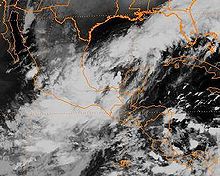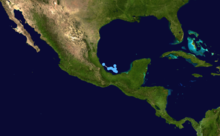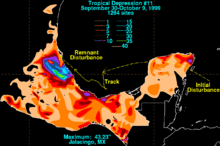- October 1999 Mexico floods
-
Tropical Depression Eleven Tropical depression (SSHS) Satellite image of Tropical Depression Eleven Formed October 4, 1999 Dissipated October 6, 1999 Highest winds 1-minute sustained:
35 mph (55 km/h)Lowest pressure 1002 mbar (hPa; 29.59 inHg) Fatalities 636 total[1] Damage $1 billion (1999 USD)
(Estimated[2])Areas affected Veracruz, Puebla, Tabasco, Hidalgo, Jalisco, Oaxaca, Michoacán Chiapas Part of the 1999 Atlantic hurricane season Tropical Depression Eleven of the 1999 Atlantic hurricane season was a slow-moving system which caused some of the worst flooding in Mexico in over 50 years. It killed 636 people according to counts by the Mexican government, caused over 1 billion U.S. dollars in damage, and left over 300,000 people homeless. Torrential rains produced by the storm flooded roadways and broke many dams, which caused over 100 deaths in one town. [3]
The event also sparked political controversy throughout the entire country, due to the citizens claiming that the government was far too slow in launching search efforts for the missing, and rescue efforts for the trapped and dying. This caused president Ernesto Zedillo to try to reduce complaints, and even caused him to yell "shut up" at a bystander. [4]
Contents
Meteorological history
The storm started as a tropical depression in the Gulf of Mexico that slowed and eventually hit the eastern coast of Mexico. The depression was formed almost directly off of the coast. It moved steadily to the south after that, but then took a turn to the north and came very close to the coast. Tropical Depression Eleven eventually dissipated, but not after causing torrential downpours, flooding, dam breaks, and hundreds of deaths in nine different Mexican states. The storm was not very well organized and never actually made landfall with the center of the storm, but still caused this disaster. [5]
The rain event from Tropical Depression Eleven began on October 12 and continued for a few days, due to the storm's very slow speed. The most severely hit areas of Mexico were the states of Veracruz, Puebla, and Tabasco. These were also the areas with the most damage to property, and the most deaths. The events that occurred after the storm, such as dam breaks, river overflows staying over, and poor rescue efforts by the government, were what caused the most death and destruction.
It was confirmed by Reuters and the government of Mexico to be the worst flood in the past 40 years of Mexican weather history. After debate by many different organizations, it was confirmed that the storm had caused over $1 billion in damage, along with 560,000 people who were left homeless by the storm. Only 86,000 of these people were put into temporary shelters after the storm, which meant there was almost 400,000 people living without shelter in these states as a result of the storm. [3]
Impact
Immediately following the storm, the government of Mexico issued a states of emergency for the state of Tabasco. In the state of Tabasco, five different rivers flooded and overflowed. This caused water deaths along with dam leaks, dam breaks, and mudslides due do the large amount of rain caused by the storm that piled up on the hilly area. Four of the nine states that were issued states of emergency were also officially declared by the national government to be federal disaster areas. Over 75 percent of the state of Tabasco was reported to be underwater after the storm. [3]
The torrential downpours also had a heavy effect on the nation's travel, especially to their air travel. The airport in the city of Oaxaca, Oaxaca, was closed indefinitely after being hit by this storm and an earthquake that occurred the week before. This was bad news for the citizens of the state of Oaxaca because they had been depending on relief supplies to be sent by the government after their homes were damaged by the two disasters.
The storm also had a large impact in the area's farming and crop supplies because the mudslides crushed crops, and the rain overflowed them. These crops were all killed, causing many farmers to lose very large sums of their annual income as a result of the storms.
In some of the areas that were hit hardest, there were reports of many disease outbreaks, including malaria, chorea, and dengue fever. These areas were also very short in food supplies due to all travel in the area being put to a virtual standstill. There were also many reports by the Mexican government of outbreaks of diarrhea, skin and respiratory infections. These cases were later attended to by organizations such as the System for Integral Family Development and the Mexican Red Cross. [6] [7]
One of the worst disasters as a result of the storm was the collapse of a defrosted side of a mountain in the town of Acalama, Puebla. This collapse crushed nearly the entire village and killed about 170 village residents.[4]
Another disaster caused by the storm was a landslide that crushed another entire village near Teziutlán, Puebla. Over 50 homes were destroyed in the incident and almost 100 dead bodies were pulled from the wreckage by rescue workers sent by the government. [4]
See also
References
- ^ http://www.emdat.be/disaster-list
- ^ MXN 10 billion. http://www.cofemermir.gob.mx/uploadtests/4054.66.59.1.STAD%C3%8DSTICAS-RIESGOS-ATENUAR.DOC
- ^ a b c ADRC DisasterReport
- ^ a b c WashingtonPost.com: Mexico Special Report
- ^ TPC ATLANTIC ELEVEN 1999 PRELIMINARY REPORT
- ^ Presidency of the Republic of Mexico. Special Coverage
- ^ BBC News | Americas | Southern Mexico bears brunt of flooding
External links
Categories:- Floods in Mexico
- 1999 floods
- 1999 natural disasters
- 1999 Atlantic hurricane season
- Atlantic tropical depressions
Wikimedia Foundation. 2010.



